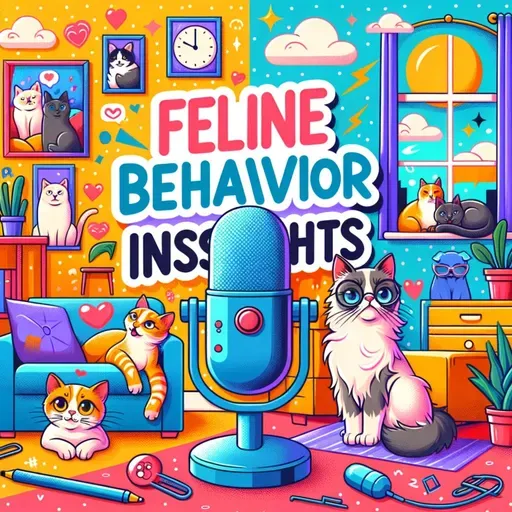
19 October 2025
The Mysterious Language of Feline Behavior: Decoding Cats' Quirks, Instincts, and Connections.
Feline Behavior Insights
About
Feline behavior has captivated humans for centuries, combining mystery, elegance, and a dash of mischief at every turn. Listeners, if you’ve ever wondered why your cat seems to live by its own unique rulebook, you’re not alone—experts like Dr. Chris Roth at Pets Best point out that each cat’s quirks, from purring to climbing, stem from personality, environment, and instinct. At their core, cats are deeply individual creatures. One cat’s loaf-like nap is another’s elaborate climbing routine. Normal behavior includes grooming, kneading, purring, and even scratching—though it might be your favorite couch. Scratching isn’t rebellion; it’s how cats clean their claws and mark their territory, so providing appealing scratching posts can save both your sanity and your furniture.
Communication is at the heart of feline behavior. According to Wikipedia’s overview of cat communication, your cat is expressing far more than simple meows. A confident cat may parade around with its tail held high, while an anxious one moves low to the ground, tail close to its body. Cat body language is a complex dance: flattened ears can signal unease or agitation, while slow blinking with soft eyelids is one of the purest expressions of trust. As Best Friends Animal Society highlights, rubbing against your leg, head-butting, and the iconic “kneading” or “making biscuits” all signify affection, reinforcing the bond between you and your feline companion.
Play is central to a cat’s world. PetMD notes that the exaggerated crouch and wiggling rear end before a pounce are echoes of their predatory wild ancestors, transformed into safe games with toys or even stray socks. A cat with wide, focused eyes and perked ears is on the hunt—even if the prey is a feather on a string. These behaviors, far from being mere entertainment, provide crucial physical and mental stimulation, keeping cats healthy and engaged.
Behavioral changes can reveal much about a cat’s health. The RSPCA and veterinary experts stress the importance of noticing shifts, such as sudden avoidance, excessive grooming, or changes in elimination habits. These can be signals of stress, illness, or environmental discomfort—a reminder for all listeners that paying close attention is essential for feline wellbeing.
Whether curled up in a warm corner, racing through the halls at midnight, or delivering that famous slow blink of trust, cats are communicating with us in ways both subtle and profound. Their mysterious actions, when decoded, tell a story of instinct, emotion, and deep connection with their human companions.
Thank you for tuning in and don’t forget to subscribe. This has been a quiet please production, for more check out quiet please dot ai.
For more http://www.quietplease.ai
Get the best deals https://amzn.to/3ODvOta
This content was created in partnership and with the help of Artificial Intelligence AI
Communication is at the heart of feline behavior. According to Wikipedia’s overview of cat communication, your cat is expressing far more than simple meows. A confident cat may parade around with its tail held high, while an anxious one moves low to the ground, tail close to its body. Cat body language is a complex dance: flattened ears can signal unease or agitation, while slow blinking with soft eyelids is one of the purest expressions of trust. As Best Friends Animal Society highlights, rubbing against your leg, head-butting, and the iconic “kneading” or “making biscuits” all signify affection, reinforcing the bond between you and your feline companion.
Play is central to a cat’s world. PetMD notes that the exaggerated crouch and wiggling rear end before a pounce are echoes of their predatory wild ancestors, transformed into safe games with toys or even stray socks. A cat with wide, focused eyes and perked ears is on the hunt—even if the prey is a feather on a string. These behaviors, far from being mere entertainment, provide crucial physical and mental stimulation, keeping cats healthy and engaged.
Behavioral changes can reveal much about a cat’s health. The RSPCA and veterinary experts stress the importance of noticing shifts, such as sudden avoidance, excessive grooming, or changes in elimination habits. These can be signals of stress, illness, or environmental discomfort—a reminder for all listeners that paying close attention is essential for feline wellbeing.
Whether curled up in a warm corner, racing through the halls at midnight, or delivering that famous slow blink of trust, cats are communicating with us in ways both subtle and profound. Their mysterious actions, when decoded, tell a story of instinct, emotion, and deep connection with their human companions.
Thank you for tuning in and don’t forget to subscribe. This has been a quiet please production, for more check out quiet please dot ai.
For more http://www.quietplease.ai
Get the best deals https://amzn.to/3ODvOta
This content was created in partnership and with the help of Artificial Intelligence AI